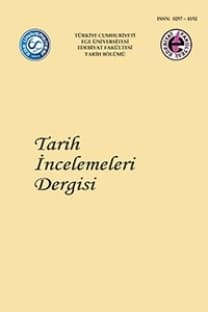Konut ve Göç: 19. Yüzyıl Kayseri Rum Evleri
19. Yüzyıl sonu Kayseri sancağındaki bütün demografik hareketlilik arasında en fazla gerisinde iz bırakan, Rum Ortodoksların göçleridir. Onlar için göç o kadar önemliydi ki, yaşamlarını sadece birçok açıdan etkilemekle kalmayıp onlar için bir nevi modus vivendi haline gelmiştir. Araştırdığımız dönemde kitlesel göçlerin sonucu olarak mimari açıdan Rumlara ait sivil konutların dış cephelerinde Batı etkisi gözlemlense de, bu hareketliliğinin etkisini anlamamızı sağlayacak olan, ithal veya Avrupa tarzı ev araç gereç kullanımını saptayamıyoruz. Nüansları bir kenara bırakırsak, Kayseri Rumları Müslüman ve Ermeni komşuları ile birlikte benzeri ev eşyaları kullanma eğilimi göstermişlerdir. Bu nedenle bu makale, süre gelen göçlerin yerli Rumların hayatlarını ev eşyası tercihleri açısından ne derecede farklılaştırdığını göstermeyi amaçlamaktadır. Ağırlıklı olarak Osmanlı şeriye sicilleri ve salnameleri, Rum sözlü tarih arşivi, Amerikan misyonerlerine ait mektup ve raporlar ve Avrupalı gezginlere ait kitaplar kullanılan bu çalışmanın sonucunda, 19. Yüzyılın son yıllarına doğru birden fazla faktörün Kayserili Rumların ev eşyası tercihlerine şekil verdiğini göreceğiz.
Anahtar Kelimeler:
Göç, Rum, Kayseri Evleri, 19. Yüzyıl
Dwelling and Migration: Greek Orthodox Houses in the 19th Century Kayseri
Among all demographic mobilities in the late nineteenth century Sanjak of Kayseri, the migratory movements of the Greek Orthodox inhabitants came to fore as the ones which left a rather colossal imprint behind. For them migration was such a significant phenomenon that affected their lives in various ways and virtually became a kind of modus vivendi. Architecturally, in the examined period a great deal of Western impressions was observed at the façades of Greek Orthodox civil dwellings. Despite this, we cannot pin down significant foreign influence in their habits of using imported or European home utensils. Certainly the verification of this idea needs us to display tangible, material proofs. Thus, to trace such evidences, various sources such as the Greek Orthodox oral tradition those based on the articulations of the Greek Orthodox of the early nineteenth-late twentieth century Kayseri on everyday life, traveller books, Ottoman provincial yearbooks, the sharia court registers and the missionary sources–the annuals and letters of the American Board of Commissioners for Foreign Missions were applied. In the end of this study, which aims to trace to what level the ongoing migrations had influenced the Greek Orthodox local inhabitants’ everyday lives from the perspective of their home equipment preferences; we shall see that towards the last years of the 19th Century more than one factor had given shape to the general tendency of the Greek Orthodox.
Keywords:
Migration, Greek-Orthodox, Houses of Kayseri, 19th Century,
___
- Akarlı 1993 Engin Deniz Akarlı, The Long Peace: Ottoman Lebanon, 1861-1920. Berkeley: University of California Press, 1993.
- Anagnostopoulou 1997 Sia Anagnostopoulou, Μικρά Ασία 19ος αι.- 1919: Οι Ελληνορθόδοξες κοινότητες, από το μιλλέτ των Ρωμιών στο Ελληνικό Έθνος (Athens: Ελληνικά Γράμματα, 1997
- Anderson1983 Benedict Anderson, Imagined Communities: Reflections on the Origin and Spread of Nationalism. London: Verso, 1983.
- Asvesti 1980 Maria V. Asvesti, Επαγγελματικές ασχολίες των Ελλήνων της Καππαδοκίας. Athens: Επικαιρότητα, 1980.
- ISSN: 0257-4152
- Başlangıç: 1983
- Yayıncı: Prof. Dr. Süleyman Özkan
Sayıdaki Diğer Makaleler
Konut ve Göç: 19. Yüzyıl Kayseri Rum Evleri
İlkel Kimlik ve Enstrümantal Kimlik
Yeni Bir Vatan. Çerkeslerin Osmanlı İmparatorluğu’na Zorunlu Göçü (1864)
The Institution of “Vigla” in the Aegean Islands during the Ottoman Period
Ayşe KAYAPINAR, M. Halef CEVRİOĞLU
Geç Ortaçağ İngiliz Toplumunu Anlamak: Tarih Yazıcılığında Bastard Feudalism Kavramının Gelişimi
Ottoman Music In Travel Books: A Path To Restructure The Forgotten Ottoman Musical Instruments
